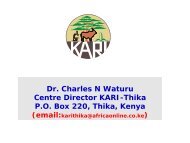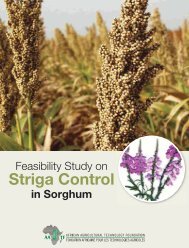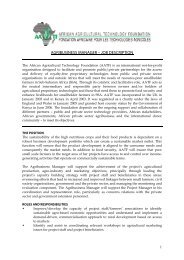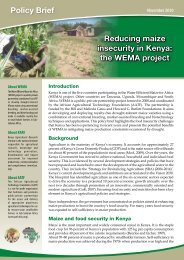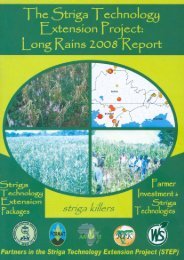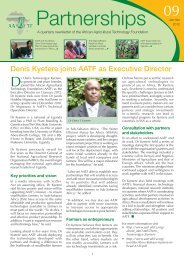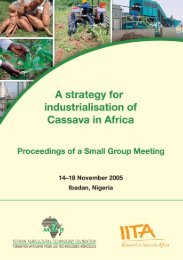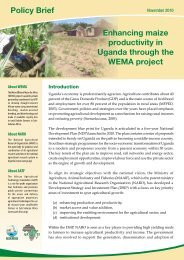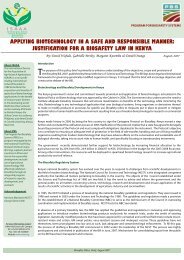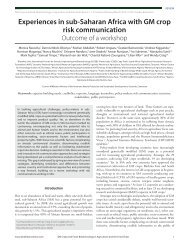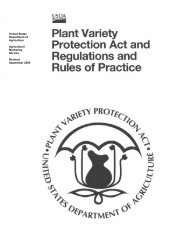Baseline Study of Striga Control using IR Maize in Western Kenya
Baseline Study of Striga Control using IR Maize in Western Kenya
Baseline Study of Striga Control using IR Maize in Western Kenya
You also want an ePaper? Increase the reach of your titles
YUMPU automatically turns print PDFs into web optimized ePapers that Google loves.
analysis <strong>us<strong>in</strong>g</strong> the same data set and this was consistent with the observed average maizeyield differences between male headed (957kg/ha) and female headed (750kg/ha) households.However, the results from the frontier analysis reported here do not necessarily imply thatmale headed households produced more maize on average than female headed households.Rather, it implies that male headed households are more likely to produce at the frontier thanfemale headed households and hence that the position <strong>of</strong> the maize production frontier isdeterm<strong>in</strong>ed by male headed households. In either case, though, there is evidence <strong>of</strong> maizeproductivity differentials between male and female headed households.All coefficients <strong>of</strong> the district dummy variables are highly significant, <strong>in</strong>dicat<strong>in</strong>g substantialmaize productivity differentials across locations <strong>in</strong> western <strong>Kenya</strong>. Kisumu and Nyandodistricts have significantly lower maize productivity relative to Bondo district. But Siayadistrict has significantly higher maize productivity than Bondo district. The results show thatfrom the four districts <strong>in</strong> Nyanza, Siaya has greater maize productivity potential. All districts<strong>in</strong> <strong>Western</strong> are more productive than Bondo <strong>in</strong> Nyanza, with Bungoma hav<strong>in</strong>g the highestmaize productivity followed by Vihiga, Teso and Busia. Siaya <strong>in</strong> Nyanza compares well withVihiga and Bungoma <strong>in</strong> <strong>Western</strong> <strong>in</strong> terms <strong>of</strong> maize production potential.6.2 Factors <strong>in</strong>fluenc<strong>in</strong>g maize production efficiencyThe estimate <strong>of</strong> the variance parameter, γ , associated with the variability <strong>of</strong> technical<strong>in</strong>efficiency <strong>of</strong> maize production, is close to the maximum value <strong>of</strong> one and is significantlydifferent from zero. In Table 6.2, the significance <strong>of</strong> γ is shown by the high asymptotic t -ratio <strong>of</strong> 20. A generalised likelihood ratio test <strong>of</strong> the significance <strong>of</strong> the <strong>in</strong>efficiency effectswas also conducted and the results are presented <strong>in</strong> Table 6.3. The null hypothesis,Η0: γ=δ0=δ1= ... =δ7= 0 , tests whether the traditional average production function isappropriate as opposed to a frontier production function. As this is clearly rejected, the testresults confirm that the traditional response function is not an adequate representation <strong>of</strong>maize production <strong>in</strong> western <strong>Kenya</strong>, given the specifications <strong>of</strong> the translog stochastic frontierand <strong>in</strong>efficiency model. In other words, the <strong>in</strong>efficiency effects are significant <strong>in</strong> determ<strong>in</strong><strong>in</strong>gthe level and variability <strong>of</strong> maize production <strong>in</strong> western <strong>Kenya</strong>. Furthermore, the nullhypothesis, Η0: δ1 = δ2 = ... = δ7= 0, tests whether the explanatory variables <strong>in</strong> the model forthe technical <strong>in</strong>efficiency effects have zero coefficients. This is aga<strong>in</strong> rejected, imply<strong>in</strong>g that,taken together, the explanatory variables have a significant impact on technical efficiency <strong>of</strong>maize production <strong>in</strong> western <strong>Kenya</strong>.Table 6.1. Maximum likelihood estimates <strong>of</strong> the translog stochastic frontier and<strong>in</strong>efficiency model for maize production <strong>in</strong> western <strong>Kenya</strong>Variable Parameter ML estimates T-ratios ElasticitiesStochastic frontierConstant β 05.601*** 8.800Land β 10.877*** 2.730 0.479***Labour β 20.107 0.392 0.201***Fertiliser β 3-0.140 -0.894 0.036***Oxen β 4-0.040 -0.180 0.278***Land × Land β 11-0.050 -0.770Labour × Labour β 22-0.079** -1.973Fertiliser × Fertiliser β 33-0.057 -1.013Oxen × Oxen β 440.119 1.40442



